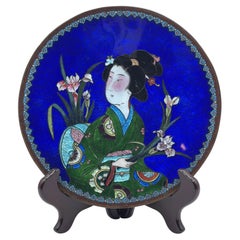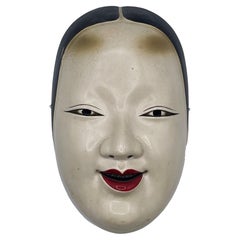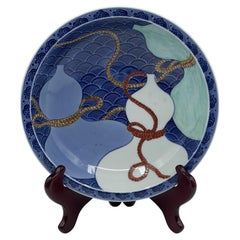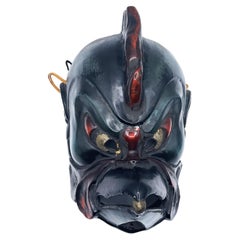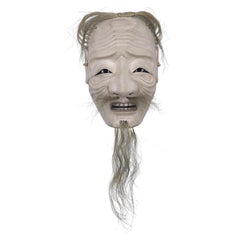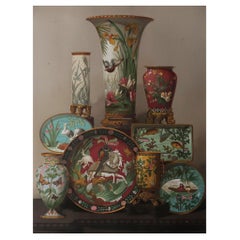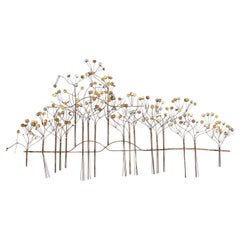Ashville Fine Arts Wall Decorations
to
1
27
26
1
Height
to
Width
to
8
4
2
1
1
5
20
1
8
12
6
1
2
4
4
12
11
4
3
3
12
10
8
7
7
27
27
27
1
1
1
1
1
Japanese Meiji Period Ukyoi Cloisonné Plate with Bijin Holding Irises, Ca. 1890
Located in New York, NY
Japanese Meiji Period Ukyoi-style Cloisonné Plate Depicting a Bijin with Irises, Ca. 1890
PERIOD
Meiji Period: 1868-1912
DIMENSIONS
Diameter: 9.75 inches
Depth: 0.5 inches
ABOUT
...
Category
Antique 1890s Japanese Japonisme Decorative Art
Materials
Metal
Japanese Noh Theater Ko-Omote Mask, Early 20th Century
Located in New York, NY
Japanese Noh Theater Ko-Omote Mask, Early 20th Century
DIMENSIONS:
Height: 8.5 inches
Width: 4.5 inches
Depth: 3 inches
ABOUT
A finely carved and painted Ko-Omote mask used in trad...
Category
Early 20th Century Japanese Japonisme Decorative Art
Materials
Wood
Japanese Edo Period Nabashima Porcelain Plate with Three Sake Bottles, Ca. 1850
Located in New York, NY
Japanese Edo Period Nabashima Porcelain Blue Plate with Three Sake Bottles, Ca. 1850
PERIOD
Edo Period ((1603-1868) – Mid-19...
Category
Antique 1850s Japanese Japonisme Decorative Art
Materials
Porcelain
Japanese Showa Period Karasu Tengu Mask, ca. 1920
Located in New York, NY
Japanese Showa Period Karasu Tengu Mask, ca. 1920
DIMENSIONS:
Height: 12 inches
Width: 8 inches
Depth: 7 inches
ABOUT
A Japanese...
Category
Vintage 1920s Japanese Japonisme Wall-mounted Sculptures
Materials
Wood
Japanese Edo Period Ko-jo Mask of an Old Man, ca. 1820
Located in New York, NY
Japanese Edo Period Ko-jo Mask of an Old Man, ca. 1820
Edo Period (1603-1868)
DIMENSIONS:
Length: 15” (with beard)
Length: 8” (without beard)
Height: 4”
Width: 5.5”
ABOUT
A Japanese Edo Period (1603-1868) Ko-jo Mask of an Old Man refers to a traditional theatrical or ceremonial mask crafted during Japan’s Edo period (1603–1868). Here's a breakdown of what this object typically represents and why it's significant:
The term "Ko-jo" (or Kojo) roughly translates to "old man" or "aged person" in Japanese. A Ko-jo mask often portrays the face of an elderly man, typically with exaggerated age features: deep wrinkles, sagging skin, a long nose, bushy eyebrows, and sometimes a beard. These masks are usually used in Noh, Kyogen, or folk performances, and occasionally in Shinto rituals.
In Noh theater, masks are used to express character types, moods, and spiritual roles. The Ko-jo mask might represent a wise elder, a spirit of age and wisdom, or even a deity.
In Kyogen, which is the comedic counterpart to Noh, old-man masks are used more playfully, often satirizing elderly characters in lighthearted scenes.
The Ko-jo mask may also symbolize ancestral reverence or longevity, tying it to folk beliefs and ritual performances.
Edo period masks...
Category
Antique 1820s Japanese Japonisme Decorative Art
Materials
Wood
Two Chinese Silvered Pewter Wall Sculptures w/ Elephants and Fruits, Early XX C.
Located in New York, NY
Two Chinese Framed Wall Silvered Pewter Sculptures with Elephants and Fruits, Early 20th C.
SOLD AS A SET 0F 2 BUT CAN BE PURCHASED SEPARATELY
Price: $4,500 each...
Category
Early 20th Century Chinese Chinoiserie Wall-mounted Sculptures
Materials
Pewter
Set of Six Japanese Meiji Period Imperial Portrait Paintings on Silk , Ca. 1880s
Located in New York, NY
Meiji Period (1868-1912) – Ca. 1880/1890
This group of portraits was shown at Chicago World’s Fair in 1893.
DIMENSIONS (Framed)
Width: 24” inches
Height: 57.5
Category
Antique 1880s Japanese Japonisme Paintings
Materials
Silk
Paul Meltsner, Portrait of a Youth, American Modernist Realism O/C, c. 1940
Located in New York, NY
American Art Deco
Modernist Social Realism
Paul Raphael Meltsner
Portrait of a Youth
Oil on canvas
Circa 1940
DIMENSIONS
CANVAS: 26 x 20 inches
FRAMED: 30 .5 x 24.5 inches
DETAIL...
Category
Vintage 1940s American Art Deco Paintings
Materials
Canvas
Alexander Cañedo, Dancing Man, Surrealistic O/C Painting, ca. 1950’s
Located in New York, NY
Mid-Century Surrealism
Alexander Cañedo
Dancing Man
Oil on Canvas
ca. 1950’s
PAINTING DIMENSIONS:
Canvas: 44 x 44 cm (17-3/8 x 17-3/8 in.)
Framed: 68 x 68 cm (26-3/4 x 26-3/4 in.)
Alexander Cañedo (Mexican-American, 1902 – 1978) was born in Mexico City as Alejandro de Cañedo; his father was a Mexican government official and his mother was from the United States. In 1918, when Cañedo was 15, his parents sent him to École nationale supérieure des Beaux-Arts in Paris where he studied under the sculptor Jean Magrou. In 1923, Cañedo traveled to Rome where he continued his art studies. In 1927, Cañedo briefly returned to Mexico. During that trip, the Mexican Government appointed him attaché to the Mexican Embassy in Rome.
In 1928, Cañedo held his first art exhibition with the Circolo Artistico in Rome, a collection of pencil drawings. More exhibitions followed in other cities in Europe. That same year, he traveled to the New York City where he exhibited widely. At this point, he began signing his work with just his last name; eventually, he also Anglicized his first name as "Alexander" and dropped the "de".
Cañedo was commissioned in 1929 to illustrate the amatory novel Orientale: The Adventure of Therese Beauchamps by the French author Francis de Miomandre. The highly stylized Art Deco results were so successful that he retained Cañedo the following year to illustrate his next novel, The Love Life of Venus.
In 1932, Cañedo was invited to have a solo show of his pencil drawings at Walter P. Chrysler, Junior's newly opened Cheshire Gallery, located in the Chrysler Building. He also had a solo exhibition at the Argent Galleries, and participated in shows of the Art Students League of New York, of which he was an active member.
By the mid-1930s, Cañedo began exhibiting watercolors. These were shown at solo exhibitions at the Arthur U...
Category
Vintage 1950s American Mid-Century Modern Paintings
Materials
Paint
Emmanuel Fougerat, O/C Portrait of La Argentinita, ca. 1920
By Emmanuel Fougerat
Located in New York, NY
DIMENSIONS:
Height: 16.25 inches
Width: 13.5 inches
Depth: 2.25 inches
Frame width: 2.5 inches
ABOUT MODEL
Encarnación López Júlvez, known as La Argentinita (Buenos Aires, March 3, 1898 – New York, September 24, 1945) was a Spanish-Argentine flamenco dancer (bailaora), choreographer and singer. La Argentinita was considered the highest expression of this art form during that time.
López Júlvez was the daughter of Spanish immigrants in Argentina, where her father had a fabric business. While living there, two of her siblings died in a scarlet fever epidemic. Consequently, she was brought to the north coast of Spain in 1901, where she began to learn Spanish regional dances.
When she was only four years old, she started learning flamenco from Julia Castelao. Her first public performance was at the age of eight at the Teatro-Circo de San Sebastián, in the Basque Country. She chose the name "La Argentinita" in deference to the famous flamenco dancer Antonia Mercé (La Argentina).
After travelling throughout Spain as a child prodigy, she settled in Madrid to perform at Teatro La Latina, Teatro de la Comedia, Teatro de La Princesa, Teatro Apolo and Teatro Príncipe Alfonso. Her success led her to tour in Barcelona, Portugal and Paris, and then Latin America.
In the early 1920s, she returned to Spain, where she worked in Madrid. Among her early performances was the 1920 premiere of Federico García Lorca's musical play El maleficio de la mariposa as "the Butterfly". She announced her retirement in 1926, but would quickly return to the show business as part of the artistic renewal that led her to the Generation of ‘27, in which she combined flamenco, tango, bulerías and boleros. She danced to the compositions of Manuel de Falla, Joaquín Turina, Isaac Albéniz, Enrique Granados and Maurice Ravel. She helped in the development of Ballet Español.
Adapting pieces to popular tradition, she toured Europe, triumphing in Paris and Berlin and participating in the artistic movements of that time along with Spanish poets such as Rafael Alberti, Federico García Lorca, Edgar Neville and Ignacio Sanchez Mejias. Sánchez Mejías, an intellectual and bullfighter, was a married man and her lover. La Argentinita retired a second time to maintain her clandestine relationship with him. However, she would return to the stage with the aid of Sánchez Mejías, who participated in the search and employment of interpreters for her subsequent performances.
In 1931, López Júlvez and García Lorca recorded five gramophone slate records, which were accompanied by García Lorca's piano. The selection of songs was prepared, adapted and titled Colección de Canciones Populares Españolas by García Lorca. Among the ten songs were "Los cuatro muleros", "Zorongo gitano", "Anda Jaleo" and "En el Café de Chinitas".
With the beginning of the Second Spanish Republic, López Júlvez formed her own ballet company called Bailes Españoles de la Argentinita together with her sister, Pilar López Júlvez, and García Lorca. López Júlvez staged several flamenco theatrical shows, including an adaption of Falla's El amor brujo (Love, the Magician) in 1933, and Las Calles de Cádiz (The Streets of Cadiz) in 1933 and 1940.[7] She travelled through Spain and Paris, where she was recognized as one of the most important flamenco artists of her time. Her company included the flamenco figures Juana la Macarrona, La Malena, Fernanda Antúnez, Rafael Ortega and Antonio de Triana, who was her first dancing partner until the 1940s.
At the end of her tour around Spain, her lover Sánchez Mejías was gored to death in 1934 in the Manzanares bullring. She sought refuge in her work and moved to Buenos Aires to dance at the Teatro Colón; from there she embarked on a long American tour. In 1936 she achieved success in New York. Afterwards, she returned to Spain but was forced to flee the country shortly before the outbreak of the Spanish Civil War. She travelled through Morocco, France, the UK, the Netherlands, Belgium and the USA, where she remained in exile in New York. From then until her death in 1945, she developed her career and became one of the biggest stars of international dance, and even participated in movies.
In 1943, she presented the flamenco troupe El Café de Chinitas at the Metropolitan Opera House in New York, with her own choreography, texts by García Lorca, scenery by Salvador Dalí and the orchestra directed by José Iturbi. In addition, she performed at the Washington DC Watergate complex with her sister.
On May 28, 1945, she gave her last performance at the Metropolitan of the orchestral work El Capricho Español, composed in 1887 by Nikolai Rimsky-Korsakov and based on Spanish melodies. At the end of the event, she had to be admitted to a hospital, where she died on September 24 from a tumor in her abdomen. She did not want to have it operated on because she did not wish to abandon dancing. Her body was repatriated to Spain in December and buried in the Spanish capital. That same year, the company of Bailes Españoles de la Argentinita was dissolved.
Among the honors she received after her death was a plaque consecrated at the Metropolitan Opera House, positioned among the medals of Alfonso X El Sabio and La Orden de Isabel la Católica to honor her merits in the field of culture.
ABOUT ARTIST
Emmanuel Fougerat (French, 1869 – 1958) was a renowned French painter, museum curator and art historian. A former student of the Regional School of Fine Arts in Rennes, Fougerat studied in the studio of Albert Maignan and that of Jean-Paul Laurens in Paris.
He was appointed director of the Nantes School of Fine Arts and was also the founder and curator of the Museum of Fine Arts in the same city. Emmanuel Fougerat was named Chevalier of the Legion of Honor in 1912. In 1923, he was placed on temporary leave from the French State in order to carry out a mandate as director of fine arts education in the Province of Quebec, Canada; where he served as an art teacher and director of the École des beaux-arts de Montréal from 1923 to 1925.
Emmanuel Fougerat’s paintings are in the following public collections:
• Nantes Museum of Fine Arts, France.
• Museum of Modern Art in Paris, France.
• Rennes Town Hall: permanent decorations.
• Museum of Fine Arts of Saint-Nazaire (destroyed in 1944), France
• National Museum of Fine Arts of Quebec, Canada.
Emmanuel Fougerat is also the author of works on several French painters, including Albert Besnard, Paul Baudry...
Category
Vintage 1920s French Art Deco Paintings
Materials
Canvas
Nicolas Issaiev, Still Life with Fruits, Original Oil Painting, Ca. 1920’s
By Nikolai Alexandrovich Isaev
Located in New York, NY
Nicolas Issaiev (a/k/a Nikolai Alexandrovich Isaev, Russian-French, 1891-1977) was a painter, graphic artist, set designer, illustrator.
In the early 1900s he studied in art scho...
Category
Vintage 1920s French Expressionist Paintings
Materials
Canvas
Bernard Taurelle, Nu, French Modernist Oil on Canvas Painting, circa 1960s
By Bernard Taurelle
Located in New York, NY
Signed lower right corner.
Stamped en verso Galerie Felix Vercel Paris - New York.
Original period frame.
Bernard Taurelle (French, B. 1931) is a famous French artist, widely known ...
Category
Vintage 1960s French Post-Modern Paintings
Materials
Canvas
Roberto Rosati, Italian Futuristic Art Deco Majolica Wall Plate, ca. 1930s
By Roberto Rosati
Located in New York, NY
This large and stunningly beautiful hand-painted futuristic Art-Deco majolica wall plate by famous Italian ceramist, Roberto Rosati depicts a peasant wo...
Category
Vintage 1930s Italian Futurist Decorative Art
Materials
Ceramic
Spanish Colonial, Penitent Mary Magdalene, Original O/C Painting, 18th Century
Located in New York, NY
Spanish Colonial
Penitent Mary Magdalene
Original oil on canvas painting
XIX century
Details
Original period frame.
Painting dimensi...
Category
Antique 18th Century Mexican Spanish Colonial Paintings
Materials
Canvas
Richard Wilt, Caesar, American Mid-Century Modern O/C Painting, Ca. 1960s
By Richard Wilt
Located in New York, NY
ABOUT ARTIST
Richard Wilt (American, 1915 - 1981) > Chronology and Exhibition History
1915 Born in Tyrone, PA
1981 Died in Ann Arbor, MI
EDUCATION:
1...
Category
Vintage 1960s American Mid-Century Modern Paintings
Materials
Canvas
David Anthony Tauszky, Portrait of a Chinese Woman, American Art Deco, ca. 1920s
Located in New York, NY
Dimensions: Height: 24” (61cm) Width: 20” (50.8cm) Frame width: 3.25” (8.12 cm)
About:
This very elegant painting is a part of the famous ‘Cantonese’ series of mainly female portraits, painter by David Anthony Tauszky...
Category
Vintage 1920s American Art Deco Paintings
Materials
Paint
Lev Mezhberg, Urban Winter Landscape, Oil on Canvas Painting, 2003
By Lev Mezhberg
Located in New York, NY
Signed and dated in the bottom right corner “L.M.03”
Dimensions:
Height: 28 inches (70cm)
Width: 40 inches (100 cm)
Lev Leonidovich Mezhberg (Ukrainian/American, 1930-2007) was born and spent most of his life in the cosmopolitan city of Odessa, whose streets and suburbs are found in many of his works. In 1958, he graduated from Odessa College of Fine Art with highest honours. Mezhberg's work has been exhibited at museums and galleries throughout the Soviet Union, the USA and Europe and is owned by such collectors as leonard Bernstein, Vladimir Horowitz, Natalia Makarova...
Category
Early 2000s American Modern Paintings
Materials
Canvas
Ivan Olinsky, Still Life w/ Chinese Porcelain Figurine & Fruits, O/C Painting, C
By Ivan Grigorievich Olinsky
Located in New York, NY
Artist: Ivan Grigorewitch Olinsky (Russian-American, 1878 1962)
Subject: Still life w/ Chinese porcelain figurine & fruits
Period: 1920’s...
Category
Vintage 1920s American Expressionist Paintings
Materials
Canvas
American School, Rural Hilly Landscape w/ Lake and Railway O/C Painting, 19 C
Located in New York, NY
Artist: Unknown.
Painting: Rural Hilly Landscape with Lake and Railroad.
Period: XIX century.
Style: American School, Primitivism.
Medium: Oil on canvas, framed.
Dimensions: H: ...
Category
Antique 1870s American American Classical Paintings
Materials
Canvas
Rolph Scarlett, Modernist Abstract Composition, Guache on Paper, Ca. 1950’s
By Rolph Scarlett
Located in New York, NY
Artist: Rolph Scarletti (Canadian, 1889 – 1984)
Object: Modernist Abstract Composition
Period: Ca. 1950’s
Medium: Guache on paper, framed
Dimensions (unframed):
Height: 9-1/3”
Width: 12”
Dimensions (framed):
Height: 22-3/4””
Width: 25-3/4”
Rolph Scarlett (Canadian, 1889 – 1984) was a consummate explorer of twentieth-century abstract painting. Never afraid of trying new styles, curious and opinionated, constantly engaged with the world around him while steadfastly aware that he was on his own path and his alone, Scarlett more than once proved to be at the artistic zeitgeist of the eras in which he lived. Exposed very early on to the work of Paul Klee through a chance meeting in Europe with the artist himself, Scarlett took up abstraction with a fervor that never diminished during his long and impressive career. To create something that had never existed before: this was Scarlett’s great cause. And that is what is most obvious when you look at Scarlett’s work—you have never seen anything quite like it.
Scarlett was Canadian-born, came of age in the Midwest, and spent few important years in Hollywood, where he designed stage sets. His work from this early period echoes Klee’s use of color, his confidence in naïve, primitive forms, and his blend of abstraction and figuration. In its flat spatial qualities it prefigures the Indian Space painting of the 1940s by a decade. He moved to New York in 1933 and eventually found his first great patron at the Museum of Non-Objective Painting, directed by Baroness Hilla Rebay and art patron Solomon R. Guggenheim. Guggenheim would collect over 60 works by Scarlett for his collection, more than any other artist outside of Vasily Kandinsky and Rudolf Bauer.
As a frequent exhibitor and lecturer at the Museum of Non-Objective Painting (MNOP), Scarlett honed his sensitive feel for bodies in space and capitalized on his trademark use of bright, vivacious colors into accomplished, perfectly harmonized geometric works. However, Scarlett soon morphed these hard-edged forms into a nuanced expressionistic abstraction which, at its best, seems to be populated by dancing forms that animate the canvases. Along this way he was advised by Rudolf Bauer, the German expatriate and one of the originators of non-objective painting in the teens. Bauer had the idea for the Museum, and Rebay, his champion, had found in Solomon Guggenheim a patron for manifesting it. When Bauer emigrated just before World War II, he wanted to meet Scarlett. The two became friends, and Bauer advised Scarlett on his work over the course of many years. Even in a 1979 interview, Scarlett began to tear up as he recalled his first meeting with Bauer, a man whose work he "worshipped," describing that, "It was a touching moment for me, I’ll tell you."
Scarlett and Rebay also had a close, important relationship, one in which he bore the brunt of her sometimes condescending, if motherly, critiques and admonitions with tolerance and gratefulness. Eventually, though, he had to push back. In a letter from 1951 he writes, "I have noticed with growing amazement that during the past three years you have accepted less and less of my work—and, that same work, which you rejected has been accepted and shown in the best and largest shows all over this country."
This period—the late 1940s to the early 1950s—did in fact correspond to Scarlett’s most critical success, and to a return to the fanciful forms and characters of his pre-war work. At the same time, he found his own rhythm and complexity using a drip style similar to, though denser and more opaque than, the one made famous by Jackson Pollock, who had worked for many years at the MNOP and with whom he shared common influences. In 1949 he had a very well received solo show in 1949 at the Jacques Seligmann Gallery, reviewed very favorably in The New York Times: "The impression made by these paintings is one of originality and strength." He was also included in a juried show "American Painting Today" at the Metropolitan Museum of Art in 1950 and in the Whitney Annual of 1951. The curator for the Whitney show in fact bypassed a selection of Scarlett’s careful geometrics in favor of a new "lyrical" drip painting—one which he describes as having had "a helluva good time" making.
Rebay articulated her loss of control over Scarlett very keenly in one of her last official letters to him: "So your way ended in the horrid jungle it is in now; even a Mr. Pollock’s smearage was not bad enough for you to have a try at; and betraying yourself, you betrayed art and my faith in you, and my present disgrace by my failure to foresee such an outrageous possibility—since you even paint objectively now."
Yet, despite the fact that he was moving in his own direction when the change in leadership took place at the Museum of Non-Objective Painting and Rebay was forced out as director, Scarlett was hit hard. He understood this change rightly as a betrayal by the establishment. Scarlett was a unique individual and soul, and was affected personally and philosophically by the idea that the movement with which Scarlett had aligned his talents seemed to disappear overnight, and his life’s work rendered valueless.
Without the Museum’s support, Scarlett decided eventually to move to the artists’ community of Shady, New York, just outside of Woodstock. He had occasional shows throughout the years, but mostly settled down to regional obscurity. He began making jewelry, which had been his first trade, and it was following a show of his jewelry in 1975 at the Jaro Gallery, that he was rediscovered by Samuel Esses, and his wife Sandy.
Samuel Esses was a successful businessman and an avid collector. He always sought out that which was unusual and, like Scarlett, was ahead of his time in many ways. For example, in 1979, Sam became enthralled with the early graffiti appearing on the New York subway trains. With the sole goal of preserving these groundbreaking yet short lived works of art he was inspired to create "The Esses Studio," a painting warehouse and workshop for graffiti artists to work in a studio, collaborate, and paint on canvas. The biggest names of graffiti writing participated—Futura, Crash, Dondi, Zephyr, and Daze to name a few. The project was well received and provided critical validation at an important time for this alternative form of abstraction to be recognized by the established art world. The success of the "Esses Studio" helped fuel an alternative fire that would propel gallerists and curators to acknowledge other street artists and provide a foundation of acceptance for the early careers of Keith Haring and Jean-Michel Basquiat. It is not a stretch to say that what Esses saw in the graffiti art of the 1970s was very similar to what he saw in 1950s-era Scarletts—something raw, honest, and melding many twentieth century influences into one unique form. Inspired by the importance of the collection and the passion of the collector, Weinstein Gallery...
Category
Vintage 1950s Canadian Mid-Century Modern Paintings
Materials
Paper
Sunshine, Original Upstate New York Landscape with Ashocan Reservoir
By Sunshine
Located in New York, NY
Sunshine was a known local artist in Woodstock and upstate New York area during 1960s. This abstract painting is of Ashocan Reservoir, located in Ulster County, New York. The reservo...
Category
Vintage 1960s American Mid-Century Modern Paintings
Materials
Acrylic
Stanley Stangren, Modernist Abstract Mixed-Media Collage, circa 1964
By Stanley R. Stangren
Located in New York, NY
Dimensions:
Unframed: 11-1/2 x 8-1/16 inches
Framed: 17-1/8 x 12-7/8 inches
Signed by the artist and dated ’64 in the lower right corner; inscribed in German: Zurich, Schweitz (Zurich, Switzerland)
This unique work of art is a mixed-media collage on paper, where the artist had generously used his own pencil, gouache and watercolor drawing with a print cut-outs.
Stanley R. Stangren (1928–2014) was an outstanding American jeweler, artist, sculptor and ceramist, residing in New York City. He worked in different styles and in different materials, including oils, watercolor, ceramic and stone sculptures; and fine jewelry.
Stangren’s painting styles varied tremendously – from complete abstract works to Holocaust themes in the style of Georges Rouault and Hieronymus Bosch to portraits in the style of Moses and Raphael Soyer. He was also a passionate lover of the performing arts, and, as a young man, spent time studying dance at both the School of American Ballet and with Martha Graham. Although he worked with dance pioneers like Ms. Graham, Anna Sokolow and Charles Weidman, an injury prevented him from pursuing dance as a career. But he found other outlets for his artistic pursuits.
In his youth, Stangrem attended the Brooklyn Museum School of Art, and graduated from the High School of Music and Art in New York City. He later studied at the Boston Museum of Fine Arts, the Art Students League, Bard Colledge and in Europe. Stangren studied jewelry design in Europe, attending Staatlische Kunst Werkschule in Pforzheim, Germany and Kunstgewerbeschule der Stadt in Zurich, Switzerland. His jewelry and designs were received with great success. His combination of precious and semi-precious stones, high-karat gold and sterling silver, and exotic materials executed with outstanding workmanship in the abstract modernist style gave a unique aspect to his designs, the metalwork usually electroformed, cast, or fused in varying textures. After returning to New York in the later 1950s, Stangren opened and maintained a ceramic business in Trenton, New Jersey. Very few pieces of his work remain from this period.
When he retired from the ceramics business, he spent much of his time enjoying the arts. He frequently attended Juilliard performances, including most of the opera and drama presentations at the School, and was especially fond of the dance concerts. The last 40 years of his life, he taught painting in the New York area and worked with Metropolitan Museum of Arts in developing annuities, for future acquisitions.
In addition, Stangren left annuities for MoMa in support of educational programs and left, in his will or through his executors, art supplies for the Harlem School of Art and benefits for the Urban Assembly organization. Mr. Stangren's love for the arts and for the performances he was seeing at Juilliard inspired him to take his participation a step further and to establish charitable gift annuities with the School.
"I realized what Juilliard offered me, being a passionate music lover, and I decided to give something back" he said. "What Juilliard achieves is remarkable. When I think of the prominent actors, dancers and musicians that have been educated there, I am always staggered. It is deeply financially satisfying to be able to give back to the School, while benefitting from it at the same time." The Juilliard School is not the only organization that Stanley Stangren...
Category
Vintage 1960s Swiss Mid-Century Modern Paintings
Materials
Paper
Irina Shtenberg, Portrait of a Young Woman, Watercolor on Paper, circa 1940s
Located in New York, NY
Unsigned.
Attributed to Irina Valeryanovna Shtenberg.
Period frame.
Dimensions (unframed): Height: 13”, width: 11”
Dimensions (framed): Height: 15”, width: 12-7/8”
All the w...
Category
Vintage 1940s Russian Mid-Century Modern Paintings
Materials
Paper
Johann Berthelsen, Manhattan Snow Storm Scene, Oil on Canvas Painting, 1960s
Located in New York, NY
This wonderful romantic painting depicts figures bustling along a Manhattan street during a snowstorm. Signed lower right.
Johann Henrik Carl Berthelsen (1883–1972)
Coming to America as a child, he enjoyed early success as an opera singer and music teacher. His friendship with the artist Wayman Adams resulted in a move to New York and experimentation with painting. When the great depression took a toll on his musical career, Berthelsen began selling oil scenes of his beloved New York City, which quickly found prominent buyers including William Randolph Hearst...
Category
Vintage 1950s American Mid-Century Modern Paintings
Materials
Canvas
Boris Solotareff, Portrait of Mr. Lautenberg, Oil on Canvas Painting, 1920s
By Boris Solotareff
Located in New York, NY
Signed en verso B. Solotareff, Lautenberg.
Original period frame, made personally by the artist.
Dimensions (without frame):
Height 16”
Width 12 ½”.
Dimensions (with frame...
Category
Vintage 1920s French Art Deco Paintings
Materials
Canvas
Sam Diamond, View of Manhattan, Oil on Canvas Painting, circa 1954
By Sam Diamond
Located in New York, NY
This is a double-sided painting -
Side 1: View of Manhattan, signed lower left and dated 1954.
Side 2 (reverse): Genre scene with porters.
Dimensions: Unframed: 20.5 x 30.5 inches Framed: 32 x 37 inches
Sam Diamond, Polish/American (1919 - 1978)
- Born May 1, 1919 in Warsaw, Poland.
- Family immigrated to the United States in November 1919.
- Began drawing at 6 years of age and continued an active interest in art throughout his school years.
- Graduated from Long Beach High School in 1936, at 16 years of age.
- Awarded a scholarship to Pratt Institute.
- Received art certificate from Pratt in 1939.
- Enlisted in U.S. Army Signal Corps. - Film Strip Division- doing artwork for training manuals from 1941-1946.
- Formed advertising art studio in 1946
- Continued painting and sculpture to present.
- Award for Sculpture and Painting, Westchester Art Society...
Category
Vintage 1950s American Mid-Century Modern Paintings
Materials
Paint
Karoly Fulop, The Baptism, Polychromed Ceramic Panel, circa 1950s
By Karoly Fulop 1
Located in New York, NY
Karoly Fulop (Hungarian, 1893-1963.) 'The Baptism' polychrome glazed ceramic signed to reverse 28" H x 24" W x 1.5" D A framed polychromed Art Deco ceramic panel, by multi-media arti...
Category
Mid-20th Century Hungarian Modern Paintings
Materials
Wood, Ceramic
$3,375 Sale Price
25% Off
Related Items
Original Antique Print of Japanese Cloisonne Enamels, Dated 1876
Located in St Annes, Lancashire
Great image of cloisonne enamels
Chromo-lithograph after A. Willms
Published by Sutton Sharpe & Co. 1876
Unframed. It gives you the option of perhaps making a set up using y...
Category
Antique 1870s English Japonisme Prints
Materials
Paper
Brutalist Brass Wall Sculpture
Located in Mexico City, CDMX
Circa 1960. We offer this Brutalist brass wall sculpture.
Category
Vintage 1960s Mexican Brutalist Wall-mounted Sculptures
Materials
Brass
Pair Of Antique Decorative Wall Plaques, Japanese, Bronze, Edo Period, Victorian
Located in Hele, Devon, GB
This is a pair of antique decorative plaques. A Japanese, bronze wall panel, dating to the early Victorian period, circa 1850.
Accentuate your wall ...
Category
Antique Mid-19th Century Japanese Decorative Art
Materials
Bronze
$1,204
H 6.3 in W 6.3 in D 0.4 in
Early Curtis Jere Chrome Raindrops Wall Sculpture circa 1970’s
By Curtis Jeré
Located in Ann Arbor, MI
Curtis Jere Early Chrome Raindrops Sculpture Signed by the Artist circa 1970’s. This sculpture has beautiful patina and vibrant color and can can hang both vertically or horizontally...
Category
Vintage 1970s American Mid-Century Modern Wall-mounted Sculptures
Materials
Cut Steel
Fabienne Jouvin Imari Japanese Asian Porcelain Wall Plates 1990s
By Fabienne Jouvin
Located in North Hollywood, CA
Vintage Fabienne Jouvin French designer decorative Imari Asian wall plates.
from the French Parisian designer Fabienne Jouvin the plates with irregular shapes and quite shallow with a beautiful Oriental Asian Japanese style depicting a man and woman portrait on each plate.
The portrait are period Imperial style, with Japanese kimono and hair style, vivid colors on each panel of the plate depicting different Asian traditional design motifs.
Colorful modern Asian motif decorative plates or shallow bowls made by Fabienne Jouvin Paris...
Category
Late 20th Century Chinese Japonisme Decorative Art
Materials
Porcelain
Antique German Hand Carved Wooden Deer Head with Glass Eyes, ca. 1920
Located in Barntrup, DE
Antique Black Forest-style German hand-carved linden wood deer head on a carved wall plaque.
An impressive antique hand-carved wall-hanging deer head made of linden wood with wooden ...
Category
Vintage 1920s German Black Forest Wall-mounted Sculptures
Materials
Wood, Glass
$1,694
H 17.72 in W 12.21 in D 7.49 in
Japanese antique wooden blocks/1800-1920/paper charms/Buddhist art
Located in Sammu-shi, Chiba
This is a wooden woodblock produced in Japan from the late Edo period to the Taisho period (about 1800s to 1920s). The material used is something like beech wood, and the wood is dec...
Category
Antique Late 19th Century Japanese Edo Wall-mounted Sculptures
Materials
Beech
$1,000
H 11.62 in W 8.78 in D 0.71 in
Japanese Showa Period Peacocks Painted on Silk
Located in Rio Vista, CA
Colorful Japanese ink and color on silk Showa painting of a pair of peacocks. Vivid colors and beautiful details with a signature and seal on right side bottom. Framed in a midcentur...
Category
20th Century Japanese Showa Paintings and Screens
Materials
Silk, Plexiglass, Paper, Wood
Japanese Carved Wood Mask of Tengu
Located in Astoria, NY
Japanese hand carved and painted wood mask of Tengu, the legendary Japanese folk religion creature. Traditionally depicted as a human-bird of prey hy...
Category
Vintage 1920s Japanese Sculptures and Carvings
Materials
Wood
Set of Three Early 20th Century Terracotta Wall Sculptures
Located in Barcelona, ES
Enhance your collection with this exquisite set of three early 20th century terracotta wall sculptures, manufactured in Spain circa 1940. These captivating pieces, in their original ...
Category
Vintage 1940s Spanish Rustic Wall-mounted Sculptures
Materials
Terracotta
$883 Sale Price / set
78% Off
H 17.72 in W 19.49 in D 2.37 in
Early 1960s Brutalist Mid Century Wall Sculpture
Located in Berkeley, CA
Origin: USA
Designer: Unknown
Manufacturer: Unknown
Era: 1960s
Materials: Steel
Measurements: 43.5" wide x 5" deep x 42.5" tall
Category
Mid-20th Century American Mid-Century Modern Wall-mounted Sculptures
Materials
Steel
Framed English Porcelain Plaque, circa 1850
Located in New York, NY
Framed English porcelain plaque, circa 1850. Signed artist Edwin Steele (son of Thomas) who lived 1804-1871.
Category
Antique 1850s English Decorative Art
Materials
Porcelain
